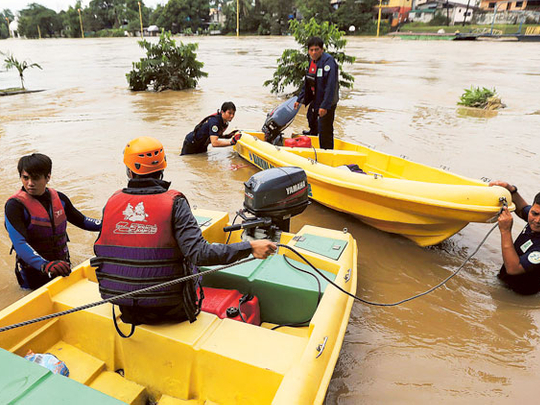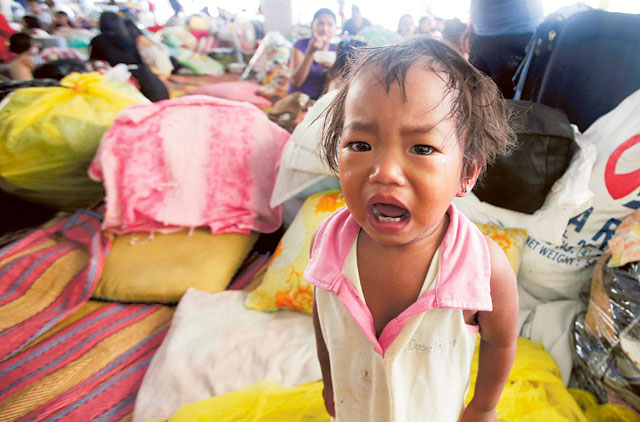
Manila: Three people were killed, three were injured, five remained missing, and 128 were rescued from two capsized ships in central Philippines and Metro Manila as Typhoon Kalmaegi rushed in from the Pacific Ocean, hit northern Luzon’s eastern seaboard, and barrelled to northern Luzon’s western seaboard, affecting 10,000 people in the region, sources said.
The fatalities and damage were initially recorded from places far away from the typhoon’s fatal path such as Metro Manila, southern Luzon, and central Philippines starting on Saturday, the sources added.
Rahima Ismael, Armando Mosqueda, and an unidentified person were killed as MV Maharlika – 2, owned by Archipelago Ferries Corp, sank near Panaoan Island, an hour after it left Lipata Port in southern Leyte, central Philippines on Saturday. Their bodies were found off Mindanao, southern Philippines, and brought to Aldonza Funeral Homes, in Surigao City, Undersecretary Alexander Pama, executive director of the National Disaster Risk Reduction and Management Council (NDRRMC), told Gulf News.
Justin Alano, 6; Melanie Guti, 15; and Jerson Sabrane, 16 were the youngest of the 113 passengers, including 31 crew members of the ill-fated ship, who were rescued in central Philippine sea by sister-ship MV Maharlike-4 and three other foreign vessels (MV Lara Venture and MT St. Martin, and MV Orient King) before sunset of Saturday, Pama said, adding that five passengers remained missing,
The ship’s manifest claimed it carried only 89 passengers, including the crew members. “The number of passengers was not reported properly,” complained Palma.
Survivors said in radio interviews that big waves tilted the ship to one side and brought 13 rolling cargoes aboard to that side, causing the ship to sink.
Meanwhile, 15 more crew members survived as MV Supershutter sank in Manila Bay on Sunday. Seven crew members aboard a life-raft were rescued by members of the Coast Guard on Manila Bay, at the back of the United States embassy on Roxas Boulevard. Eight other crewmen swam towards the vicinity of Manila’s central Luneta Park, Pama said.
As Typhoon Kalmaegi entered northern Luzon, its wide diameter of 400 kilometre brought in southwest monsoon rains, resulting in the cancellation of 43 flights at airports in Metro Manila, northern and southern Luzon, and central Philippines. Though far from Kalmaegi’s central path, these affected areas were also flooded, said Pama.
Some 708 passengers were stranded as authorities prevented 16 sea vessels and 83 rolling cargoes from leaving seaports in far southern Luzon’s Bicol region. “Storm surges rose to three metres high in affected southern Luzon’s eastern coastal areas,” said Pama.
Power outages hit Metro Manila’s suburban Quezon City on Sunday night, said Pama, adding all these incidents came from collaterally affected areas away from the Typhoon’s wrath.
“Figures will still dramatically rise with additional data coming from direct and hard hit northern Abra Provinces and the Ilocos region,” said Pama.
Initial reports from northern Luzon said a total of 11 roads and three bridges were not passable due to landslides and flashfloods in four regions.
Typhoon Kalmaegi’s maximum sustained winds of 120 kilometre per hour near the centre and powerful gustiness of up to 150 kilometre per hour, moved at 30 kilometre per hour from Abra in northern Luzon’s eastern side to Laoag City near the western seaboard at four in the morning of Monday, said the weather station.
“It will be 400 kilometre away west northwest of Laoag City on Tuesday morning,” the weather station predicted.
Before the storm’s landfall, Pama went on TV and called residents in three towns in northern Luzon’s Abra to evacuate. “Do not wait for the storm to hit you,” he warned, adding that storm surges could sweep away villages and people.
Typhoon Haiyan, a four-grade storm, triggered storm surges that killed 8,000 people, affected 15 million residents, left six million jobless, and damaged even evacuation centres in central Philippines last November.
Some 20 storms savagely damage the Philippines every year.
It is part of the Asia Pacific’s Ring of Fire where volcanic eruptions and earthquake also occur.












